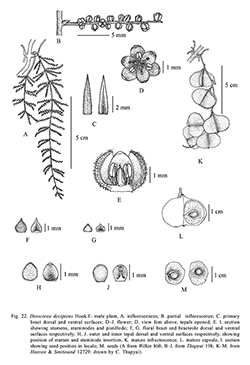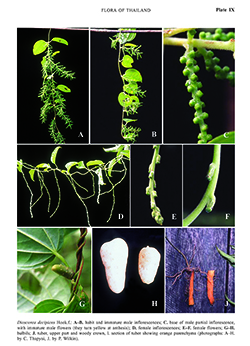e-Flora of Thailand
Volume 10 > Part 1 > Year 2009 > Page 43 > Dioscoreaceae > Dioscorea
11. Dioscorea decipiens Hook.f.wfo-0000390457
Fl. Brit. Ind. 6: 293. 1892; Craib, Bull. Misc. Inform. Kew 1912: 407. 1912; Prain & Burkill, J. & Proc. Asiat. Soc. Bengal 10: 31. 1914; R.Knuth in Pflanzenr. 4, 43: 287. 1924; Prain & Burkill, Bull. Misc. Inform. Kew 1927: 245. 1927; in Fl. Indo-Chine 6: 745. 1934; Ann. Roy. Bot. Gard. (Calcutta) 14(2): 400. 1938; Hô, Câyco Viêtnam 3, 2: 932. 1993; Ding & Gilbert in Fl. China 24: 297. 2000; Wilkin, Thapyai & Chayamarit, Kew Bull. 62: 252. 2007. Fig. 21, 22; Plate IX.
Accepted Name : This is currently accepted.
Synonyms & Citations :
Description : Climber to 12 m. Tubers one per growing season, often with withering tuber of previous season, ca 5–20(–30) by 0.5–1.5 cm long, cylindric to clavate, vertically oriented. Indumentum usually present on all parts, simple hairs, 0.2–0.35 mm long, but often glabrescent to some degree. Stems 2.5–5 mm in diam., twining to the right, annual, toward base woody and spiny, unarmed on distal stems, terete. Leaves simple, opposite, sometimes subopposite or alternate towards base, blade usually ovate to very broadly ovate, sometimes ovate-oblong, chartaceous, 3–5-veined, margins entire, base obtuse to rounded, sometimes subcordate to cordate, apex acute to acuminate, obtuse or rarely retuse, forerunner tip horny and sometimes deflexed, deltoid to deltoid-acuminate; petioles 1.2–4.3 cm long, terete; cataphylls 4.5–7 by 3–5 mm, ovate; bulbils present in some races, 34–50 by 8.2–25 mm, clavate to globose or ovate. Inflorescences spicate, pendent, tepals inserted on a discoid torus; male inflorescences compound, 1–2 per axil, partial inflorescences 1–3(–5) per axil, peduncles 0.1–0.4 cm long, axes 0.5–2.8 cm long; female inflorescences simple or compound, compound inflorescences 1 per axil, simple/partial inflorescences 1–2(–3) per axil, peduncles 0.5–1.2 cm long, axes 2.1–15(–25) cm long. Male flowers with tepals ovate to broadly so, outer 1.2–1.5 by 1–1.1 mm, ovate, inner 1.0–1.1 by 0.7–1 mm, ovate to broadly ovate; stamens 3, staminodes 3. Female flowers as in Fig. 21D–K, Pl. 9F. Capsules as in Figs. 21A, 22K, 15–17 by 21–27 mm. Seeds 3–3.5 by 3.5–4.5 mm, rounded-lenticular to ovoid-lenticular, wing 13–14.5 by 11.5–12.5 mm, extending all around seed margin.
Thailand : NORTHERN: Mae Hong Son (Khun Yuam, Pang Ma Pha), Chiang Mai (Doi Chiang Dao, Doi Suthep-Pui, Nam Tok Mae Klang, Nam Tok Mae Sa), Chiang Rai, Phrae (Mae Yom), Uttaradit (Queen Sirikit Dam, Phichai, Phu Soi Dao), Tak (Doi Musoe, Umphang, Tung Yai Naresuan), Phitsanulok (Ban Ken Tung, Ban Tin Tok), Khamphaeng Phet (Huai Nam Tai, Khlong Lan); NORTH-EASTERN: Loei (Dan Sai, Na Haeo), Nong Khai (Phu Wua), Sakon Nakhon (Phu Phan); EASTERN: Nakhon Ratchasima (Khao Yai), Ubon Ratchathani (Phu Chong Na oi); SOUTH-WESTERN: Kanchanaburi (Mae Klong), Phetchaburi (Thung Luang), Prachuap Khiri Khan (Nong Ke); SOUTH-EASTERN: Chachoengsao (Ang Rue Nai), Chanthaburi (Taruang), Trat (Bo Rai).
Distribution : China (Yunnan), India, Burma (lectotype), Laos.
Ecology : Open and disturbed areas of mixed deciduous forests (with or without bamboo), sometimes in hill evergreen forests, 50–1,250 m alt. Flowering: August–October; fruiting: September–January.
Vernacular : Man tueng (มันตึ่ง)(Chiang Mai, Chiang Rai); man i mu pa (มันอีมูป่า)(Tak); man khai (มันคาย)(Phetchaburi); man khamin (มันขมิ้น)(Chanthaburi).
Uses: Tubers edible without preparation other than peeling when boiled, steamed or roasted.
Conservation Status: IUCN red list category LC (IUCN 2001).
Notes: This species is a close relative of Dioscorea pubera Blume, which has an allopatric distribution in north-eastern and southern India and Indonesia (Sumatra and Java), but the latter species has six functional stamens. There is a form of D. decipiens around Chiang Mai with a particularly large, deflexed, horny forerunner tip and often a retuse leaf apex e.g. Winit 756, Wilkin 922. Wholly glabrescent forms (D. decipiens var. glabrescens C.T.Ting & M.C.Chang; see Ding & Gilbert 2000) have not been encountered in Thailand, but there appears to be considerable variation in pubescence density and the developmental stage at which it falls.



